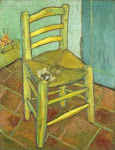
Wow, here's an archaeological shocker: the famous Capitoline Wolf (pictured) has a suggested new date...a good 1700-1800 years later than art historians have traditionally supposed. The Wolf has long been thought by the majority of scholars to be Etruscan in manufacture, dating to the first quarter of the 5th c BC (but the babies are usually described as Renaissance, legend attributing them to Antonio Pollaiuolo), and she's in all the survey textbooks as exactly that. The Wolf is also the symbol of the city of Rome, appearing everywhere in civic logos. But Prof. Adriano La Regina, a highly respected scholar, went on record yesterday in the newspaper La Repubblica, revealing that a series of radiocarbon tests done at the University of Salerno show the Wolf is...medieval. The new date was first proposed by conservator Anna Maria Carruba, who worked on the statue's restoration and followed-up with further research.
My first reaction: Oh pooh, I have to rework my lectures! I'll probably take her out from the intro survey class for the sake of simplicity (now I have time to discuss the Arezzo Chimera, yippee), but leave her in my upper-level Roman Art class' relevant lecture, revising to discuss issues of attribution and dating, and the contention over the revised view. My second reaction is one, honestly, of disappointment. The Capitoline Wolf is (was) such an archaeological icon. Not that there's anything inferior about medieval art--certainly not--and the news makes her no less beautiful an artwork, but it'd be hard thinking of her as anything but Etruscan. Read more about the Shocking News here in the Guardian. The Associated Press article points out that the Capitoline Museums director is still skeptical, and that more tests will come. Not surprisingly, some are reluctant to accept the news. La Regina claims that civic authorities deliberately sat on the new evidence, but the museum director denies this.






2 comments:
It is still a beautiful work of art.
To me it never looked like a wolf. My third book is taking me deep into wolf territory these days, and this one looks definitely like some kind of hound. Look at the morphology of the head.
The story also teaches us to take scholarly certitudes with a grain of salt.
That's an interesting point, Catherine, the statue looking houndlike. It's possible that it was not intended as a wolf but that during the Renaissance, it was reinterpreted or misunderstood as one and Romulus/Remus added to it. But then, animals in medieval art (if we can call this medieval) often don't look 'realistic' (lions spring to mind). I don't remember offhand the year of the earliest documented 'sighting' of the Capitoline Wolf (my Roman books are on campus right now and I'm not). Supposedly it was found on the Capitoline Hill and then linked to Cicero (I believe it's Cicero) saying there was a wolf statue on that spot in his day, and it was struck by lightning. There is damage on the Wolf's paw that traditionally was thought to be from the lightning. Tradition more than hard evidence gave the attribution, it's true.
This will be a good discussion for the students in Roman Art this fall. Like you say, it's a lesson that scholarship evolves. Especially these days, when there are all kinds of tests and technology not available to scholars of years past. For bronzes, they can test the amount of tin or copper in a sample and compare that to ancient usage, etc., and thanks to X-rays, UV, even tiny cameras up inside the bellies of things, we understand more about how ancient bronzes were made. From what I read, the conservator who originally became suspicious of the Wolf did so because of the technique.
I hope there will be a good scholarly write-up eventually, with all the details of the testing. It's fascinating what conservators can do and learn!
Post a Comment